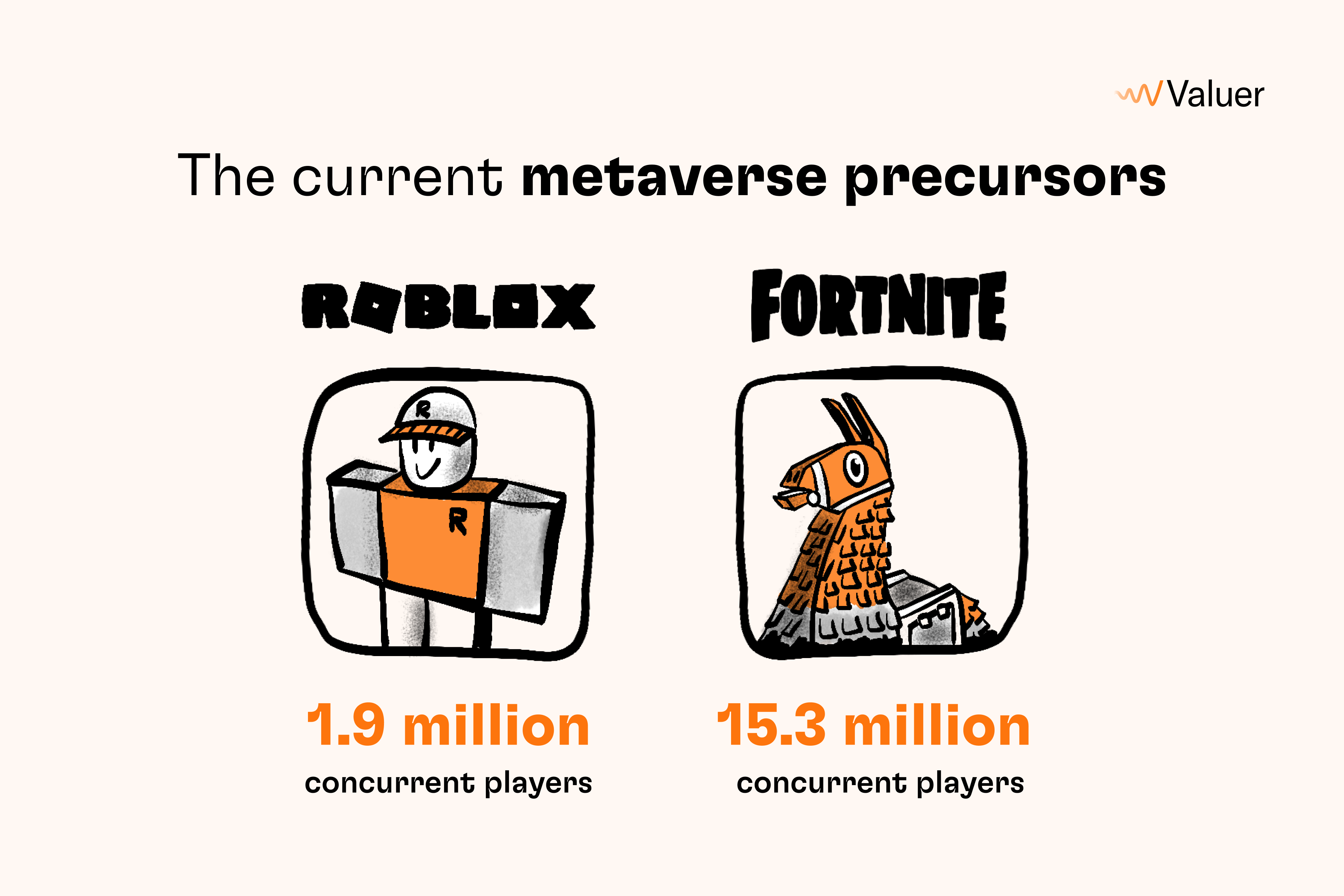*Updated September 2022
Before we get into the meat and potatoes of this article, I want to set the tone right by saying the “Metaverse” is still a very ethereal concept, and I am not going to spend much trying to define what it is or what it will be. Doing so would effectively be like asking someone from 1995 to define what present-day social media is—pure speculation. However, if that is an itch that you need scratching, we have recently published an article asking What is the Metaverse? Just Another Buzzword? In it, we dive into the history and etymology of the term, where is the current technology, and what is the potential.
Continuing on, from newsfeed to Buzzfeed or from Zuckerberg’s meme-generating Meta presentation to Disney patenting metaverse technology for theme parks, there is no doubt that there’s blood in the “Metaverse” waters, and the big sharks are starting to swarm.
However, this article is going to look at the people and the once startup gaming companies that, for decades, have been crafting immersive stories and worlds for people to escape into. From 1990’s LAN parties to arena-filling e-sports, we’re going to be looking at how decades of online gaming have slowly created the necessary technologies and infrastructure for what will inevitably hold up the future concept of "The Metaverse."
And finally, after Microsoft’s recent statement of their acquisition of Activision Blizzard to the tune of $68.7 billion, we’re going to look at whether gaming companies are going to be true gatekeepers of the Metaverse.
Can Non-gaming-related companies like Disney, Nike, Meta, and Qualcomm hope to compete in this space and become the new Metaverse companies without similar mega-deals? Will this trigger a whole new series of anti-trust regulations? And will the historically skeptical and non-conformist nature of gamers help keep the Metaverse “potential” held lovingly within a gaming industry that paved the way for its existence?
Going back to your mom’s basement
From what started off in the 1980s as something that only highly passionate computer nerds engaged in (thanks to Mom’s basement), LAN (or Local Area Network) parties have now grown into events that draw tens upon thousands of people. The now multi-national gaming event Dreamhack is the perfect example of this. Starting off in the basement of an elementary school in the early 1990s in Malung, Sweden, it has now grown to encompass three yearly tradeshow events that draw the attention of thousands of live participants and millions online.
The technology of LAN essentially came out of a need to connect an array of computers before the widespread adoption of the internet. And even as the internet became ubiquitous and consoles began to dominate the mainstream gaming market, many PC gaming and startup gaming companies remained loyal to towards PC gaming crowd. LAN continued to flourish amongst the PC gaming elite, as it allowed for better cooperative multi-play without latency due to slow or poor internet connection.

While LAN technology might not be commonly understood by those outside of PC gaming or computer science, it paved the way for technologies that are still widely used today. In fact, Ethernet is the most commonly known and used LAN technology today and is still the foundation for events like Dreamhack and many major eSports.
And how does this relate to the rise of Metaverse companies and the context of this article, you might ask? Well, it speaks to the level at which cooperative play and interaction has been at the core of many gaming companies for over 30 years. In fact, many of those startup gaming companies of the 1990s like Blizzard, of the now aforementioned Activision Blizzard, were essential in taking cooperative digital interaction from something shared by thousands of people, to something shared by millions.
The mainstream rise of the MMO
One cannot look at the history of MMORPG’s (massively multiplayer online role-playing games) without first acknowledging early games like Ultima Online which launched in 1997. At its peak, the online multiplayer game had around 100,000 subscribers and boasted an average simultaneous player count of 12,500. Now, for anyone that can remember the speed of the internet in the late-90s, this was a tremendous feat and speaks volumes to the power of hardcore gamer loyalty and in-community word-of-mouth marketing. With that said, due to the limitations of the technology at the time, the game would still be a niche by today’s standards.
[Related Article - What is the Metaverse? Just Another Buzzword?]
It wasn’t until 2004, and the launch of a new MMO, that the industry began to show its true potential for shaping what we now view as ubiquitous—online interactive experiences.
That MMO was World of Warcraft.
From their humble beginnings as a startup gaming company in Irvine, California, it wasn’t until the launch of World of Warcraft (or WoW as it is colloquially referred to) that they became a household name. After 18 years, eight expansions, the game still boasts over 1.1 million active subscribers. The game reached a peak of 12 million subscribers in 2010.
This is where the true potential of active virtual gameplay and online interaction started to truly show its potential. And for anyone that has actually played WoW for any amount of time, you'll be very familiar with the concepts that are often spoken about in describing the Metaverse. Things like player-driven economies, social gathering points, virtual real-estate, etc. World of Warcraft was not the first or only MMO to adopt or build these concepts into their game.
But for many years, it was the most popular—leading to years of speculation as to what would be the next “WoW-killer" MMORPG? While the MMO trend is current not what it was in the mid-2000s, there is still an active community. However, it was until we all started to get computers in our pockets that the industry changed again.
Mobile gaming companies steal the spotlight
In parallel to the rise of PC and console gaming, mobile gaming was also on the rise but limited by device development. Games like Snake and Tetris were wildly popular on pre-smartphone devices.
.png?width=4050&name=Mobile%20gaming%20companies%20steal%20the%20spotlight%20(1).png)
However, it wasn’t until Steve Jobs came out on stage in his iconic black turtleneck in 2007 that everything began to change. The introduction of the iPhone brought with it a whole new realm of possibilities, and it wasn’t but a few years later that the world became enthralled by mobile gaming. Angry Bird’s dwarfed the PC and Console market by more than 250 million downloads in 2021. And within 5 years of its release, Candy Crush managed 2.7 billion downloads.
All of the sudden there was a mobile gold rush, everyone was looking for mobile gaming companies to invest in, and the technology that allowed for handheld multiplay accelerated by leaps and bounds. And while the investors had their wallets out, the gaming entrepreneurs took notice.
Not more than seven years after the release of the iPhone, rapidly developing smartphone technology allowed for the next step in the mobile gaming experience—Augmented Reality. And XXX took advantage of that and released Pokemon Go—a ground-breaking experience that brought us one step closer towards blurring the boundaries between virtual reality and our physical reality. This change in the cultural zeitgeist towards where we “live our lives” is essential to the global adoption of something like a Metaverse.
Now, the rise in popularity of mobile games has not been without controversy, especially amongst the “hardcore” gamer crowd. Most notably, is when Activision Blizzard’s earnings saw a 10% dip after Blizzcon 2018 when they decided to review that the next iteration in their iconic Diablo franchise was being developed for mobile. Hardcore gamers have always been notoriously skeptical of the meteoric rise of mobile gaming. So this seems like an overwhelming deaf move by the company to forsake the same core fans that propelled them from their startup gaming company days.
What this illustrates is that with such a stark division between core gamers and the larger mainstream gaming market, a lot will need to be done to bridge that gap if there is to be one singular Metaverse. What seems more likely is the blossoming of numerous types of metaverses with different demographics in mind—a multi-metaverse, if you will.
The current Metaverse precursors
Let’s put aside the astronomical amount of funds and resources that some companies, like Meta, are pouring into the Metaverse development. Over $10 billion dollars and 10,000 people, to be exact. If history has taught us anything, just because a company can pour tons of money and resources into a trending concept doesn’t indicate that the public will buy into it.
While more gaming-centric companies, like Epic and Roblox, aren’t exactly Davids to Facebook's (Meta) Goliath, they have already excelled at IPs that are much further along in development and management systems that have core ‘metaverse' fundamentals. As mentioned earlier, these are things like virtual real estate, social hubs, character customization, in-game live events, etc.
The most notable games to embrace metaverse fundamentals, without explicitly calling their games "The Metaverse," are Epic Game's Fortnite, Roblox, and Microsoft’s Minecraft. Each of these games has embraced and built upon their player-base's desires for more in-game options that revolve around social interaction. In fact, the core gameplay loop has long been overshadowed by what has become, for each game respectively, a place to meet up, hang out with friends, and express personal creativity.

The important thing to note here is that the average user of these games is between ages 8 and 24. With the largest demographic of Fornite being 18-24, the majority of Roblox players being under the age of 12, and the average age of players in Minecraft is 24.
What we can speculate from this is that for many children and young adults within this age range, many of the concepts that will fuel the Metaverse are already known—as they are already familiar with the companies that are utilizing those concepts. So, while Meta throws billions into trying to penetrate this already flourishing market, if they don’t work fast the market will ripen. Meanwhile, spending astronomic resources building a "Grandma" Metaverse.
Entering the Metaverse through acquisition
On the topic of Minecraft, one can’t begin to speak about The Metaverse without the mention of Microsoft’s recent announcement of the acquisition of Activision Blizzard for $68.7 Billion. The largest single gaming acquisition in the history of the industry—three times over. If you pair that with their purchase of ZeniMax Media in 2020, owners of the iconic Bethesda Softworks and Bethesda Game Studios, you can see that Microsoft has their eyes on a very specific prize.
While they have been definite players in the Console Wars since the early 2000s, their Windows platform has made them familiar with PC gamers since essentially the beginning.
If their acquisition of Activision Blizzard goes through and doesn’t spark a repeat of history by putting the company back in the crosshairs of antitrust legislators, then it will cement Microsoft as one of the largest gaming companies in the world. They will have control of decades of iconic game franchises, a distribution platform that could be developed into a central Metaverse hub (GamePass), and years of experience with developing virtual social experiences through their management of Minecraft.
In a recent episode of Sway, tech reporter Kara Swisher spoke with Xbox head Phil Spencer and speculated that in the race between the mega-corporations to develop the Metaverse, “Phil Spencer could give Mark Zuckerberg a run for his money.”
Wrap up on gaming companies and the Metaverse
In conclusion, if there is one solid piece of advice that we could give around the topic of the Metaverse is, “don’t trust any solid pieces of advice about the Metaverse.” It is too new, too fresh, and still years from being the reality that's being promised in boardrooms across the world. In addition, the hype has also brought along quite a lot of snake oil salesmen looking to capitalize on FOMO (fear of missing out) around the topic.
However, if you must take away something solid from this article, you could speculate that investment in startup gaming companies is a fairly good place to start. The gold rush around this Metaverse topic is reaching a fever pitch, and if the core gaming community doesn’t discover and launch several new startup gaming companies into the race, there is a fairly safe bet that companies like Microsoft will continue to build their gaming empire through acquisitions. And that Meta will continue to try and buy their way into it.
There should be no doubt that gaming is going to be a fundamental part of whatever becomes of The Metaverse, and discovering gaming companies to invest in is going to be a key differentiator between those that win or lose the race.












